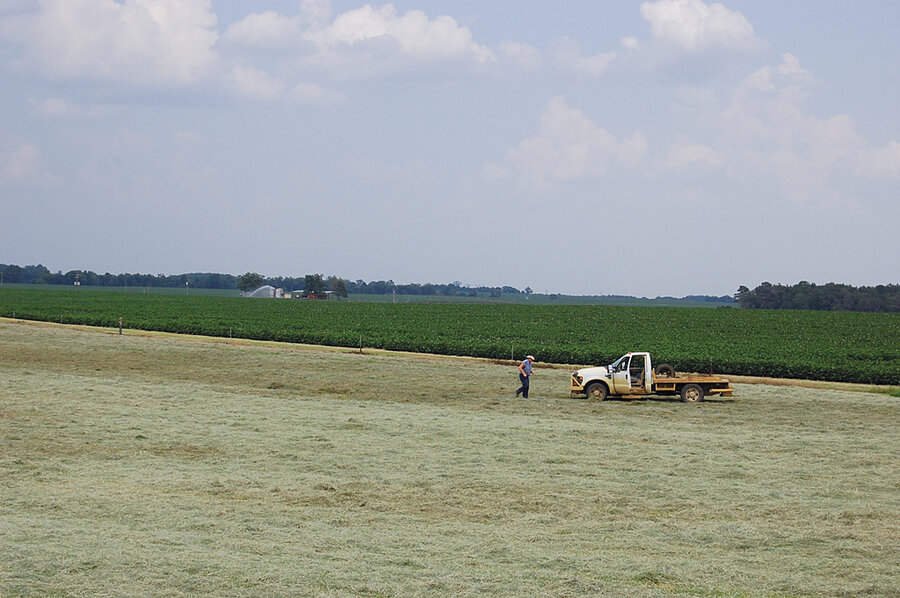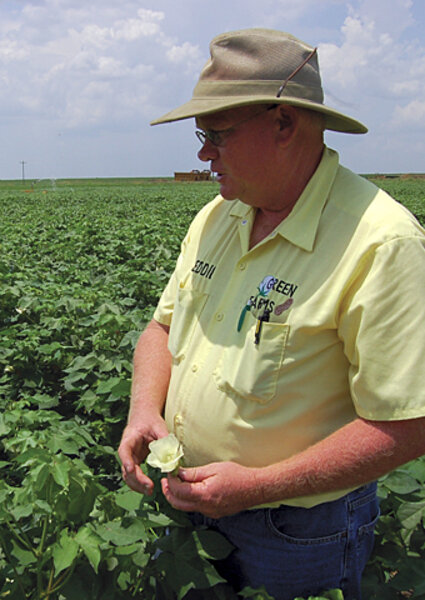Drought: Farmers dig deeper, water tables drop, competition heats up
Loading...
| Unadilla, Ga.
The long-term drought that is unlocking disaster aid for 40 percent of America's most fertile hillocks and valleys has turned central Georgia into what Deputy Secretary of Agriculture Kathleen Merrigan called in July "the toughest place in the country."
So on those rare afternoons when dark clouds stack up against the heat-seared horizon, farmer Eddie Green allows himself a smile.
"That's what I like to see," says Mr. Green, who farms 500 acres of mostly corn and cotton in Dooly County. "At least someone has a shot at getting some rain."
His rain dreams are more altruistic than selfish, as he no longer depends on the rain to irrigate his crops. The epiphany came last year.
"It was the hottest, driest summer I'd ever seen," he says, standing amid impressive rows of flowering cotton, "and I had the biggest, most profitable crop I'd ever had."
Instead of just praying for rain, which former Georgia Gov. Sonny Perdue famously did during the north Georgia drought of 2007, Green has joined a growing number of Peach State farmers to consider a once-unimaginable tactic to deal with the drought: full irrigation.
Thirty years ago, 95 percent of Georgia farmland was "dry," or nonirrigated. Since 2007, when the current dry weather pattern established itself, Georgia farmers added irrigation to half a million acres, an increase of one-third. Green himself has gone from 50 percent irrigated in 2007 to nearly 100 percent today, largely in response to the drought – and as insurance against what some fear could be a longer-term pattern of hotter weather.
"The drought motivates everything I do at this point," says Green, who has his own wells.
So far his efforts have paid off, putting him in the not entirely welcome position of profiting from a national hardship – the worst US drought since 1956. He isn't alone. Dooly County as a whole increased the value of its row crop production from $100 million in 2010 to $140 million in 2011, perhaps the drought's apex.
Paradoxically, if you have water, there may be no better time to be a farmer. US net farm income last year reached a record $98 billion, and with commodity prices still high and rising, that record could be challenged this year, even with drought-lowered yields.
But irrigating to slake the soil's thirst puts attempts to achieve drought resistance on a collision course with growing concerns, even in the humid Southeast, about water allocation and depletion of the aquifers, adding more uncertainty for America's agricultural juggernaut.
"Once those irrigation pumps get turned on, it reduces the surface flow in river valleys and tributaries. And once people start establishing those connections, it becomes a legal battle," says Brian Fuchs, a climatologist with the University of Nebraska's National Drought Mitigation Center in Lincoln. "That's the danger of seeing that shift to irrigation – it's not an infinite resource. At some point the water table will respond."
The US Geological Survey has found central Georgia suffering from long-term ground water depletion similar to that experienced by the Ogallala aquifer beneath Texas and the High Plains aquifer beneath Nebraska and Kansas.
Currently, the vegetable meccas of California's Central Valley and the grain capitals of the High Plains account for half of all ground water depletion in the United States, according to a 2012 study by the University of Texas. Consequently, within 30 years, "the nation's food supply may be vulnerable to rapid ground water depletion from irrigated agriculture," the study concludes.
"What's going to be left for us to drink?" inquires Johnny Bartlett, selling Hardy Farms boiled peanuts at a shack in Montezuma, Ga.
History has taught farmers some hard lessons. After the Dust Bowl years, hardier hybrids caught on, and seed manufacturers continue to market new, drought-resistant varieties. Tax and other state incentives have encouraged "conservation tilling," which spares topsoil and saves water by using cover crops to protect the earth and ease evaporation.
For centuries, "dry land" farming has been the norm in the usually verdant and rain-soaked South, and remains so in large parts of the drought-stricken Midwest. But in this current manifestation of short- and long-term drought, irrigation has moved from a supplemental boost that evens out annual yields, making the enterprise more predictable, to a necessary crutch.
"If you believe that food and fiber are integral components of our national defense in terms of adequate supply to the people of this country, then I think the investment in irrigation and conservation efforts is a good thing," says Chuck Ellis, Dooly County's longtime agricultural extension agent.
The need exists beyond the parched South.
Compared with the South's sandy, drier soils – "Believe it or not, we're always about 10 days from a drought," one Georgia farmer says – the loamy earth of the Midwestern Corn Belt is far less susceptible to dry weather, able to hold onto rainfall for much longer.
But given corn's thirsty demands, a record-sized planting tied to attractive $8-per-bushel prices, and hot, dry conditions across the Midwest, the simmering drought is now causing major crop failure, higher feed prices for ranchers, and an onslaught of disaster politics. In Missouri, which the most current US Drought Monitor says is enduring the most extreme drought, Gov. Jay Nixon signed off on $5 million in emergency funds in late July that farmers can apply for to dig new wells to serve parched plots.
Missouri is not the only place where water politics is heating up. In Arkansas, limits on water usage are already cropping up as some chicken farmers are being asked to stop using municipal water systems because public wells and reservoirs can't keep up with demand as the drought wears on.
Even in Alabama, the second-wettest US state, the legislature passed a major tax incentive bill in July to encourage farmers to invest in well drilling, pumps, and irrigators.
Alabama has barely 200,000 acres under irrigation, far fewer than its neighbors Georgia and Mississippi. But despite being blessed with high average rainfall, Alabama farmers, too, are beginning to hedge their bets against a potentially drier future.
"Farmers ... are realizing that if they want to be sustainable and continue to farm, they're going to have to have a reliable source of water," says Sam Fowler, director of the Alabama Water Resources Research Institute at the University of Alabama, Huntsville.
Congress, for its part, is focusing on the short-term effects of the drought, potentially to the detriment of long-term planning. Before its August break, lawmakers wrestled over whether to scrap the 2012 farm bill – which includes an end to direct payments to farmers in exchange for broader insurance coverage – in favor of a one-year emergency extension of the current bill to deal with the drought damage.
While the extension would include billions in emergency aid, House Republicans are insisting that the aid be paid for by eliminating billions worth of funding for conservation and water management programs.
"We recognize farmers need aid in this emergency drought situation, [but] sacrificing the very programs that help mitigate the impacts of drought and other disasters is extremely shortsighted," Gene Schmidt, president of the National Association of Conservation Districts, complained.
Drought is part of the natural state, and it's far from clear whether the dry conditions will persist. In fact, the National Oceanic and Atmospheric Administration Climate Prediction Center is expecting a Pacific El Niño to develop, which could restore moisture this year to some of the most drought-stricken regions.
Yet some climatologists see the current drought as part of a larger global pattern toward higher evaporation rates that will continue to force farmers even in wet parts of the US to compete more assiduously for ground water.
"These changes will probably result in reduced soil moisture for crops, increased demands on ground water resources, and greater competition among water users in the arid western United States," writes Oregon State University resource economist John Antle in a recent paper titled "Agriculture and the Food System: Adaptation to Climate Change."
That tension is already being felt in Georgia, which is locked in a decades-long legal battle with Alabama and Florida over the flows of the Chattahoochee and Flint river systems. So far, while acknowledging that aquifer levels are as much as 40 feet below normal, Georgia's environmental permitting agencies have continued to approve well-drilling permits for farms.
Farmers say flow metering shows they are using a fraction of the water that critics contend. But in Apalachicola, Fla., where water levels are at record lows thanks to low flows coming out of Georgia, activists say that farmers – or, more succinctly, farm policies – are partly to blame.
"Droughts are naturally occurring events; but the way the water is being managed in Georgia, the droughts are much deeper and last for more extended periods," says Dan Tonsmiere of the Apalachicola Riverkeepers. "Everybody on the river says, 'I'm only using this much. I'm not affecting the river.' But it's the cumulative impacts that have dropped the flows in the spring and early summer on the Apalachicola during drought times by 30 and 40 percent."
"The reality is that we can do so much better," Mr. Tonsmiere adds. "What farmers are seeing now is that the drawdowns can affect the farmer next door. I think that helps to get us to a place where we understand the situation better and understand that there has to be limits, all of which can help build the political will to share the water."








